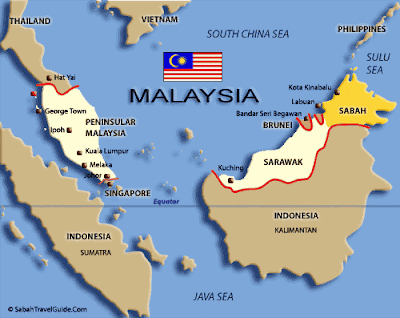About Sabah: A little bit you need to know about Sabah
 |
| Why You Must Visit Sabah, Borneo of Malaysia......... |
 |
| Sabah The Land Below the Wind. |
SABAH Known as ‘The Land Below the Wind’ because geographically, it is below the typhoon belt, Sabah sits at the northern tip of Borneo. It has one of the world's greatest treasures of rainforests and wildlife. Mount Kinabalu, South East Asia's highest mountain, is found in Kinabalu Park. Excellent dive sites are available at Sipadan Island and at the Layang-Layang atoll.
Sabah's colourful people comprise 31 different indigenous groups and unique cultures.
For the main attractions are its outstanding national parks, which include Kinabalu National Park, the Crocker Range Park, and the Sepilok Orang Utan Sanctuary. Others come to enjoy the islands of Tunku Abdul Rahman National Park and the diver's paradise of Pulau Sipadan. However, Sabah possesses a number of other attractions as well, all of which are worth exploring.
International access is through Sabah's capital, Kota Kinabalu. Domestic travel in this vast state is via daily domestic flights to the various towns with and out of the state.
 |
| Map Of Sabah. |
Situated on the beautiful island of Borneo, Sabah is one of the thirteen states which Malaysia is made of. Sabah is the second largest state in Malaysia and shares the island of Borneo with Sarawak, Brunei, and Indonesian Kalimantan.Ideal for backpackers, Sabah is richly blessed with nature diversity, unique cultures, fun adventure, beautiful beaches, and fantastic cuisines for the adventurous taste buds. We have it all, from the world’s largest flower – the Rafflesia, one of the highest mountains is South East Asia – Mount Kinabalu, to one of the world’s top dive sites – Sipadan Island.Not only will you be amazed by the places to see and things to do here, you will also be treated with unique Sabahan hospitality. Explore the unique culture and tradition of Sabah and get ready to experience sweet memories to last a lifetime!The people of Sabah are known as Sabahans. Sabah is the third most populous state in Malaysia after Selangor and Johor; it also has one of the highest population growth rates in the country.There are currently 32 officially recognized ethnic groups in Sabah with the largest non-indigenous ethnic group being the Chinese and the largest indigenous group being the Kadazan-Dusun people. Two other larger ethnic groups in Sabah are the Bajau and Murut, compared to other states in the country; Sabah has relatively very small population of Indians and South Asians.Apart from the Sabahans’ very own diverse mother tongues, Bahasa Malaysia (national language) and English is widely spoken; Mandarin and some Chinese dialects are also widely spoken.
About Sabahan
The people of Sabah are divided into 32 officially recognised ethnic groups. The largest non-bumiputra ethnic group is the Chinese (13.2%). The predominant Chinese dialect group in Sabah is Hakka, followed by Cantonese and Hokkien. Most Chinese people in Sabah are concentrated in the major cities and towns, namely Kota Kinabalu, Sandakan and Tawau. The largest indigenous ethnic group is Kadazan-Dusun, followed by Bajau, and Murut. There is a much smaller proportion of Indians and other South Asians in Sabah compared to other parts of Malaysia. Cocos people is a minority ethnic residing in Sabah especially at the Tawau Division. Collectively, all persons coming from Sabah are known as Sabahans and identify themselves as such.
Sabah demography consists of many ethnic groups, for example:KadazanDusun,Malay,Kwijau,Murut,Bajau,Illanun,Lotud,Rungus,Tambanuo,Dumpas,Mangka’ak,Suluk,Orang Sungai,Melayu Brunei,Kedayan,Bisaya,Tidong,Maragang,Orang Cocos,Paitan,Ida’an,Minokok,Rumanau.Sabah born Chinese (Malaysian),Sabah born Chinese with mixed indigenous parentage Example: Bumiputra Sino Kadazan etc.,Lundayeh,Other inhabitants:Filipino – Chavacano,Visaya,Ilocano,Suluk,Badjao,Iranun,TausugIndonesian – Bugis,Jawa,Timoris,BanjarIndian – Punjabi,TamilSarawakian indigenous – Iban,Penan,Dayakreference wikipedia
Sabah Welcome You
 |
| Sabah Place of Interest. |
Chinese Version
English Version
http://www.sabahtravelguide.com/mapguide/default.asp?page=hotsprings
WELCOME TO:Borneo Holidays, Sabah Tourism & Sabah Sipadan Island
Travel Guide
Kota Kinabalu City 12 Years Before/Ago!!
 |
| Kota Kinabalu Year 1996. |








No comments:
Post a Comment